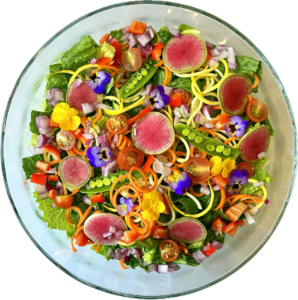Vibrant Nutrition: Unlocking the Power of Eating Colorfully
March 13, 2024
Eating a varied diet that includes a range of colorful fruits and vegetables is an important part of a healthy lifestyle. Here are just a few reasons why your plate should look like a rainbow:
Eye appeal: Let’s face it, a plate filled with a variety of colorful foods just looks more appetizing. When you’re trying to eat more fruits and vegetables, it helps to make them visually appealing.
Prebiotics for your gut: Prebiotics are non-digestible fibers that feed the beneficial bacteria in your gut. Different types of fruits and vegetables contain different types of prebiotics, so by eating a varied diet, you can support a healthy gut microbiome.
Asparagus: Contains inulin, a type of prebiotic fiber that promotes the growth of beneficial bacteria in the gut.
Garlic and onions: These aromatic vegetables contain fructooligosaccharides (FOS), which serve as prebiotics and support gut health.
Artichokes: Rich in inulin, artichokes are a great source of prebiotic fiber that nourishes beneficial gut bacteria.
Leeks: Similar to onions and garlic, leeks contain FOS and inulin, supporting the growth of beneficial gut flora.
Digestive health: A diet rich in fruits and vegetables can help to improve digestive health by providing fiber, water and other nutrients that support regular bowel movements.
Staying hydrated is essential for softening stools and promoting regular bowel movements. Fruits and vegetables with high water content, such as cucumbers, watermelon, and tomatoes, contribute to overall hydration and digestive health.
Antioxidants: Fruits and vegetables are rich in antioxidants, which are compounds that help to protect your cells from damage caused by free radicals. Different types of fruits and vegetables contain different types of antioxidants, so by eating a varied diet, you can get a wider range of these protective compounds.
Volume eating: Fruits and vegetables are low in calories but high in volume, which means they can help you feel full and satisfied without consuming too many calories. This can be especially helpful if you’re trying to manage your weight.
Heart health: Research suggests that diets rich in fruits and vegetables may lower the risk of heart disease. The high levels of dietary fiber, potassium, and antioxidants found in these foods have been associated with reduced blood pressure, improved cholesterol levels, and enhanced cardiovascular function.
Cancer prevention: Numerous studies have indicated that a diet abundant in fruits and vegetables may help reduce the risk of certain cancers. The presence of various phytochemicals, such as flavonoids, carotenoids, and glucosinolates, possesses anti-cancer properties, including antioxidant, anti-inflammatory, and detoxification effects.
Brain function: Consumption of fruits and vegetables has been linked to improved cognitive function and a reduced risk of age-related cognitive decline. The abundance of vitamins, minerals, and antioxidants in these foods supports brain health by reducing oxidative stress, inflammation, and neuronal damage.
Immune support: Fruits and vegetables provide essential nutrients, such as vitamins A, C, and E, which are critical for maintaining a robust immune system. Regular consumption of these nutrients as well as other nutrients such as zinc, selenium and vitamin D can help support overall immune health.
So, the next time you sit down to a meal, try to include a variety of colorful fruits and vegetables on your plate. Not only will it make your meal more visually appealing, but it will also provide a range of health benefits. Just aim for a diverse mix of colorful fruits and vegetables to support your overall health. It would be helpful to peruse the produce section of the grocery store and try some different vegetables and fruits to your cart each week.
In addition to focusing on the colorful array of fruits and vegetables, it’s essential to recognize the importance of overall diet patterns and the other components of your plate. While incorporating a variety of colorful plant foods is beneficial, it’s equally crucial to consider the balance and diversity of your entire diet. Including whole grains, lean proteins, healthy fats, and dairy or dairy alternatives can provide additional nutrients and contribute to a well-rounded eating pattern. Strive for balance, moderation, and variety in your meals, aiming to create a plate that is both visually appealing and nutritionally balanced. By embracing a holistic approach to eating, you can maximize the health benefits of your diet and support your overall well-being.



